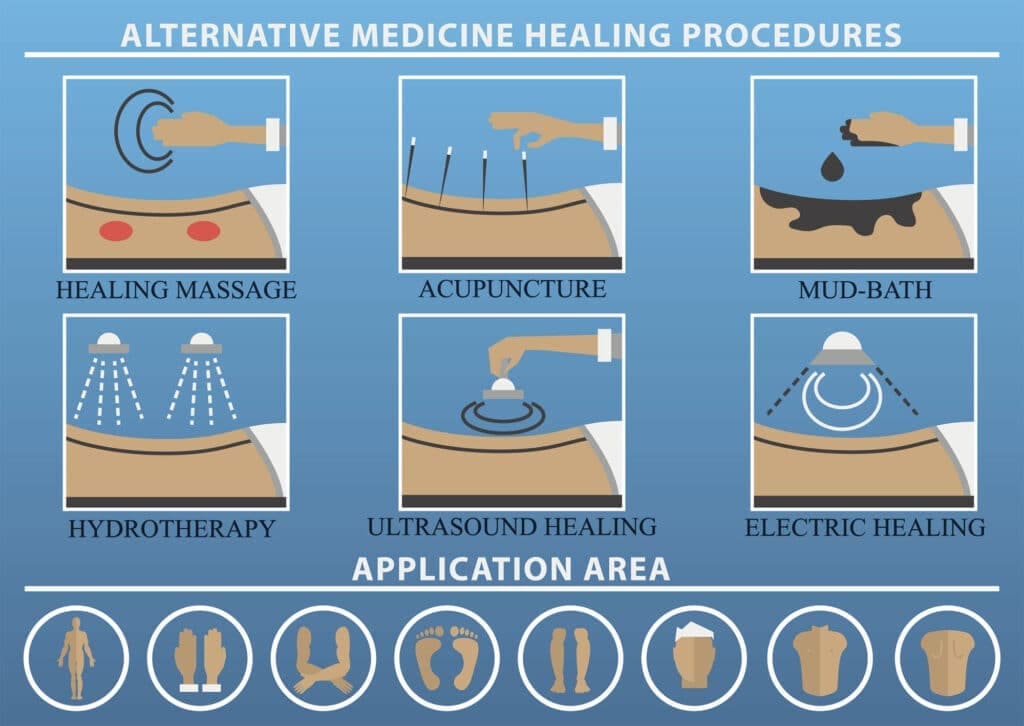Trying to finding alternative treatments for pain can bring you face-to-face with the ugly side of the internet. Online, you will find troves of people eager to share their success and horror stories in an attempt to convince you to try or avoid certain treatments.
But the truth is, complementary and alternative medicine can affect each person differently. What works for your neighbor or friend may not help you. Just like with pain medication and pain management strategies, each person has to find what works best for them. Oftentimes, however, this can take a lot of time. In this article, we provide tips for finding the best alternative treatment for you.
What Does “Alternative” Really Mean?
Even the label “alternative medicine” can cause you to feel disdain. But don’t let this type of language fool you. The distinction between “alternative” and “mainstream” has increasingly blurred, with many doctors now recommending therapies that were once thought of as wacky pseudo-treatments.
“Alternative treatment” is the umbrella term given to all non-traditional therapy options, covering everything from osteopathy to healing crystals. Almost anything that isn’t conventional medication can be labeled “alternative”.
One of the reasons why alternative therapies have been discounted for so long is because the word covers such a wide range of techniques. Legitimate and long-established treatment practices, including many mind-body therapies, were lumped in with unproven and sometimes dangerous new treatments. This helped to tarnish the reputation of many more credible alternative therapies.
Thankfully, research, patient testimony, and a clearer understanding of the nature of painful conditions have opened the door for pain patients to try new forms of relief.
Major Alternative Treatments You Should Know About
These common alternative treatments for pain have shown reasonably effective results for a significant number of patients:
1. Acupuncture
Although ancient in origin, acupuncture has become mainstream in the West. Millions of people each year now benefit from acupuncture. The practice of acupuncture relies on the insertion of very thin needles into a patient’s skin, at precise points, for extended periods of time.
Research shows that this therapy can reduce pain in some patients by as much as 50%. It can especially benefit those who suffer from headaches, low back pain, fibromyalgia, and osteoarthritis.
2. Stress-reduction and relaxation techniques
Stress can cause a physical reaction in the body by tensing your muscles and exacerbating any underlying pain issues. Stress reduction comes in various forms: relaxation therapy, hypnosis, meditation, guided imagery, and breathing techniques. These all rely on the brain to control the body’s reaction to stress. Stress reduction techniques can help with a variety of chronic pain issues.
3. Massage Therapy
Massage therapy is a form of stress-reduction, as well as a type of physical therapy. Physical manipulation of the body’s soft tissues by a masseur can ease tension, boost circulation, calm the nervous system and relieve muscle pain. It can be particularly effective for those suffering from fibromyalgia, rheumatoid arthritis, and specific muscle or joint injuries.
Chiropractic massage also falls in this category, although its practice is a bit more physically jarring than massage therapy. Chiropractic can help with spinal and neck pain.
4. Exercise
Most people wouldn’t consider exercise as either a form of pain treatment or a kind of alternative medicine. But research shows that low-impact exercise can significantly reduce chronic pain. What form of exercise you engage in doesn’t really matter. You should choose your exercise based on your physical ability and pain problems. Some of the more common activities that can decrease pain include yoga, tai chi, walking, and swimming.
5. Biofeedback
Biofeedback is a relatively new practice that teaches people how to consciously influence physical processes that are normally performed without thinking, such as heart rate, blood pressure, and muscle tension. By gaining control over these functions, you can become more aware of your body’s reactions to pain, and regulate them accordingly. This helps to prevent feedback loops from escalating your pain.
There are of course other types of alternative treatments for pain that vary in efficacy and legitimacy. These include aromatherapy, supplements, hydrotherapy, naturopathy, and osteopathy. The scientific basis for these is unclear, and effectiveness tends to be very patient-dependent. Some cite no effect at all, while others experience significant pain relief.
Finding What Alternative Treatments Work for You
With so many options, finding alternative treatments for pain that work for you can take some time, and usually involves some trial and error. Just because a treatment has worked well for other patients with your condition does not guarantee that it will work for you.
Similarly, just because something works once, does not mean it will always be effective. And, to make things even more complicated, some therapies take some time to show an effect. So simply trying every option once isn’t necessarily the best route to finding effective long-term pain relief.
1. Consider your options
For most people, a systematic approach works best to properly assess how effective a particular therapy is for pain relief. When evaluating an alternative therapy, consider the following:
- Are you comfortable with the concept of this treatment?
- Are there options for trying this treatment locally?
- How expensive is the treatment, and is it covered by your insurance provider?
- What is the recommended frequency of treatment?
- Does it overlap with any other kind of treatment you are receiving?
- What does “success” for this treatment look like?
- What are the possible side effects?
2. Find a good practitioner
The next step is to find a reputable practitioner for your treatment. Some alternative therapies have professional committees overseeing them, but others don’t. Do your research: read patient reviews, check for certifications, and ensure that the practitioner works from an established business that upholds rigorous health and safety standards.
Additionally, consider whether the practitioner has experience with people suffering from the same chronic pain issue you have. Whenever possible, ask your doctor or friends for recommendations.
3. Give it a go
If you’re comfortable moving forward, remember to give both the practitioner and the treatment a fair shot. If you find an alternative therapy isn’t really doing anything for you, it may not be the therapy itself that’s the issue. Instead, you might benefit from finding a different practitioner. Just as it sometimes takes a while to find a doctor who understands chronic pain well, it can sometimes take a while to find a massage therapist, chiropractor, or acupuncturist who understands your body and needs.
However, if a therapy seems to have no effect at all over time, bear in mind that it simply may not work for your body. Be prepared to move on, and incorporate other alternative treatment options into your treatment plan.
Safety and Side Effects
Safety should always be your first concern when trying any new medical treatment, regardless of its origin. Unfortunately, the unregulated nature of some alternative therapies means that they can be risky. It is always smart to talk to your doctor before starting any new treatment.
Some treatments may be riskier for certain people – for example, many alternative therapies are considered a higher risk for pregnant women. So always remember to keep your practitioner up-to-date with your health status.
Remember: You Need a Unified Approach
Most doctors and practitioners recommend approaching alternative therapies with an open mind and viewing them as just part of a well-rounded pain treatment approach. As such, alternative therapies are not a replacement for pain medications or traditional treatment, and they are not a cure.
Instead, alternative treatments can be used in tandem with more traditional options, and as a complement rather than a replacement. Used in this way, they can significantly improve the quality of your life and reduce chronic pain.
What Are Your Favorite Alternative Treatments for Chronic Pain?
Let us know in the comments below!
Join the Pain Resource Community
Did you know Pain Resource has different groups for different conditions?

